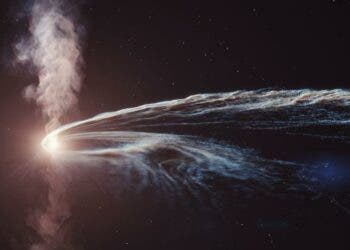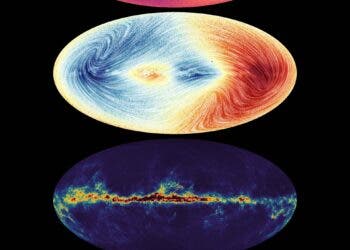
It sounds like the plot of a bad 1990s TV series: two bright siblings become separated at birth only to meet years later; the two could not be more antagonistic. Believe it or not, physicists at UC Berkeley and the Smithsonian Astrophysical Observatory at Harvard University claim this is more or less the story of our very own sun. Our solar system, they say, was born as a binary, but the twin — much colder and dimmer — shot somewhere in the cold recesses of the outer solar system. Every once in a while, Nemesis comes close enough to wreck havoc by disturbing asteroids in the outer belt. Some now believe Nemesis had a hand in the great mass extinction that wiped out the dinosaurs. Most stars in the same class as our Sun must have formed this way, according to a controversial paper set to appear in an upcoming edition of the Monthly Notices of the Royal Astronomical Society (arXiv).
Are all stars born in a litter?

Many stars actually have companions. In Star Wars, the fictional desert planet of Tatooine orbits around a pair of binary stars and since the movie came out, scientists have learned how surprisingly common these are. The English astronomer William Herschel (1738–1822) made the first discovery of a true binary system in the 1700s. He observed the motion of a pair of stars and concluded that they were in orbit around each other. Our nearest star, Proxima Centauri, is a triple star system.
In the 1980s, scientists suggested the presence of Nemesis, a second star — either a brown dwarf, dim red dwarf or white dwarf — in the sun’s system as a reason behind the periodic mass extinctions that occurred in Earth’s history. Every 26 million years or so, some paleontologist suggest, Nemesis’ motion disturbs asteroids and other space rocks in the cold margins of the solar system, flinging some on a collision course with the Earth. Such an asteroid may have killed all the dinosaurs 65 million years ago.
Even today, however, Nemesis is nowhere to be found. Steven Stahler, a UC Berkeley research astronomer, and Sarah Sadavoy, a NASA Hubble fellow at the Smithsonian Astrophysical Observatory, have come across what they think is the next best thing. Working with the VLA nascent disk and multiplicity survey (VANDAM,) they investigated the dense Perseus cloud about 600 light-years away from Earth where many young stars were present using. Their conclusion was that all Sun-like stars are probably born with a companion.
“We are saying, yes, there probably was a Nemesis, a long time ago”

“We ran a series of statistical models to see if we could account for the relative populations of young single stars and binaries of all separations in the Perseus molecular cloud, and the only model that could reproduce the data was one in which all stars form initially as wide binaries. These systems then either shrink or break apart within a million years,” Stahler said.
VANDAM is sensitive enough to identify very young stars less than half a million years old known to belong to Class 0, as well as ‘toddlers’ like stars between 500,000 years and 1 million years old, which belong to Class 1. In total, the analysis suggests the cloud nurses 45 lonely stars, 19 binary star systems, 5 other systems that contain more than two stars.
Zooming in, the team found that all Class 0 stars separated by less than 500 astronomical units, or AU, were binary and aligned with the axis of the cloud. One astronomical unit is the average distance between the sun and Earth (93 million miles), which a means wide binary companion to our sun would have been 17 times farther from the sun than its most distant planet today, Neptune (today, because some think there’s a mysterious Planet 9 waiting to be found). Class 1 stars, on the other hand, tended to be clumped together at 200 AU and weren’t aligned with the cloud’s axis.
Out of all the modeled scenarios, the only thing that could explain the distribution of stars seen by the astronomers was the conclusion that all stars of masses around that of the sun start off as wide Class 0 binaries in egg-shaped dense cores, after which some 60 percent split up over time.
“The idea that many stars form with a companion has been suggested before, but the question is: how many?” said first author Sarah Sadavoy, a NASA Hubble fellow at the Smithsonian Astrophysical Observatory. “Based on our simple model, we say that nearly all stars form with a companion. The Perseus cloud is generally considered a typical low-mass star-forming region, but our model needs to be checked in other clouds.”
This is the first time evidence has been presented to support the idea that most Sun-like stars are born as binaries, a long-assumed hypothesis — one that lacked teeth until now. Previously, computer simulations, like by Pavel Kroupa of the University of Bonn, concluded that all stars are born as binary.
“The key here is that no one looked before in a systematic way at the relation of real young stars to the clouds that spawn them,” Stahler said. “Our work is a step forward in understanding both how binaries form and also the role that binaries play in early stellar evolution. We now believe that most stars, which are quite similar to our own sun, form as binaries. I think we have the strongest evidence to date for such an assertion.”
This is just the beginning, though. The findings and models presented in the new study provide ample ground for other researchers to build on. In time, we might learn more about the physics that govern this rule. Whatever’s the case, it’s exciting to hear about the possibility, no matter how faint it may be, of finding a star somewhere in our neighborhood.






